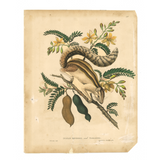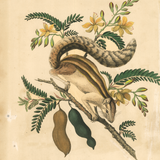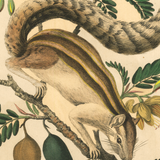James Forbes
The Indian Squirrel and Tamarind (drawn 1769)
Engraved by W. Hooker after a drawing by James Forbes
Original Aquatint (hand-coloured) published between 1813-1835
28 x 21 cms / 11 x 8.5” app.
Non-exportable.
(The work will be shipped without a frame. Framing is available on request.)
*
With an ever-growing global interest in the Company School and the allied art styles of the colonial period - we launch a series of curations featuring vintage prints from this period - signaling a new direction for the Red Earth collection. Who better to start with than James Forbes, one of the earliest British artists, whose musings of the natural world are capable of leaving an indelible mark on your mind - and adding life and colour to any room.
James Forbes (1749–1819) was a British artist and writer, employed by the East India Company, and lived in India from 1765 to 1784. His notes and sketches concerned varied aspects of Indian life, from its natural world to architecture. These illustrations are extracted from his iconic work Oriental Memoirs (editions published between 1813-1835), focusing on his visual experiences of India, but also including observations on parts of Africa and South America.
Description of the Illustration from the book:
"The Indian Squirrel and Tamarind
These are both of the natural size and colours. There are larger squirrels in India, more like those in Europe; but the little beauty here delineated is common in every town and village throughout Hindostan; perfectly familiar in the houses and gardens of natives and Europeans: the stripes are sometimes of a darker brown. The tamarind leaves and blossoms are of the usual standard; the fruit is shorter than is generally seen, on account of the size of the plate."
*
Condition Report: In reasonably good condition overall. Tears along the central bottom part, and bottom and right edges, discolouration and stains in the work, as are clearly visible in the images.






